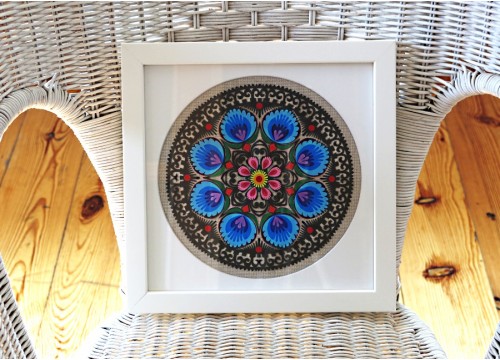
| You have no items in your shopping cart |
Transportation cost: Poland: 14 - 16 zł, Worldwide: from 22 zł

| You have no items in your shopping cart |
A hand-made by a master of Polish handicraft and beautifully framed traditional Łowicz paper cut-outis the Pearl of the Central Region. A special attention is drawn to extraordinary play of shapes and colours – its rich ornamentation is characteristic of Łowicz paper cut-outwhich is created by gluing consecutive elements of the pattern on top of one another.
The presented paper cut-outis a typical example of a classical Łowicz star – one of the two most popular paper cutouts in Łowicz Region. It is a symmetrical composition filled with vegetable motifs. This paper cut-outis a medium-sized composition made with exceptional care to details. There is a daisy in the middle surrounded by rings with multi-coloured flowers, leaves and geometrical motifs. The colourful elements are interwoven with discreet black adornments.
Check out how interestingly this paper cut - out can decorate todays' interior!
Special attention should be drawn to a very elaborate and artistic paper cut-outframe which was individually chosen by a professional framing studio. The frame is made from maroon wood. The maroon passe-partout with a pastel pink window was matched with a pink motif situated in the centre of the paper cutout. An interesting, distinct and colourful composition was created as a result. The round-shaped paper cut-outis fitted in a square frame, which additionally creates an interesting play of shapes. A pane protects the paper cut-outagainst destruction. The frame is equipped with a loop which enables it to be hung.
A cutout is a colourful picture made of paper, created by intricate cutting. It is one of the most characteristic elements of Polish folk art. Nowhere, apart from Poland, the variety of paper cutouts is so large. Paper cutouts developed in mid-19th century, mainly in central and eastern Poland, and were one of the most important forms of house decoration.
It is possible that cutouts were inspired by stars sticked to windows in Jewish houses. Cutouts were made by women: they used paper bought from travelling salesmen. They were inspired by nature and their imagination. It is interesting that cutouts are made on the spot, without drawing a model first. Initially, they were cut with sheep scissors, held by blades to use the energy of flexible steel.
Cutout style developed in Central Poland was slightly different from the style in the eastern part of the country. Here it is not only shape that is important, but also the colour. Lowicz cutout is a composition of 5, 7, or even 10 colours. "Gwiozda" and "Kodra" are the most important types. They are made by gluing consecutive layers of elements. "Gwiozda" is a symmetrical composition, filled with floral motives: trees mainly, sometimes also birds. "Kodra" is a rectangular cutout, often showing scenes from everyday life. In the past "Kodra" was attached to ceiling beams as a decoration. Today also it may beautifully decorate your house.
Stefania has been making her cutouts for 40 years. She makes them according to her own designs. Her favourite type is Lowcz Kodra with scenes and geometric, open-work Gwiozda (with cocks and peacocks). She also makes Easter eggs, ribbons, postcards and bookmarkers. She uses various types of scissors in her work - traditional sheep scissors, but also small ones. Her work is distinguished for its precision and intricacy. The cutouts she makes are famous not only in Poland, but also in many European countries (like France, Austria, England, Denmark and Germany), and even on the other side of the Ocean: in the United States, Canada and Australia. Stefania has won 12 diplomas and awards for her work, including first places in competitions: "Easter Folk Art" and "Lowicz Cutout - Souvenir from Poland". Stefania belongs to the Association of Folk Artists in Lublin. She willingly shares her experience with young people, participating in school workshops.
No customer reviews for the moment.
















